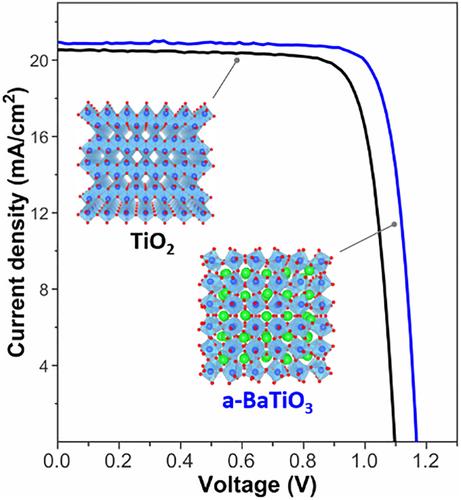当前位置:
X-MOL 学术
›
Energy Environ. Mater.
›
论文详情
Our official English website, www.x-mol.net, welcomes your
feedback! (Note: you will need to create a separate account there.)
Amorphous BaTiO3 Electron Transport Layer for Thermal Equilibrium-Governed γ-CsPbI3 Perovskite Solar Cell with High Power Conversion Efficiency of 19.96%
Energy & Environmental Materials ( IF 13.0 ) Pub Date : 2023-04-03 , DOI: 10.1002/eem2.12625 Changhyun Lee 1 , Chanyong Lee 1 , Kyungjin Chae 1 , Taemin Kim 1 , Seaeun Park 1 , Yohan Ko 2 , Yongseok Jun 1
Energy & Environmental Materials ( IF 13.0 ) Pub Date : 2023-04-03 , DOI: 10.1002/eem2.12625 Changhyun Lee 1 , Chanyong Lee 1 , Kyungjin Chae 1 , Taemin Kim 1 , Seaeun Park 1 , Yohan Ko 2 , Yongseok Jun 1
Affiliation

|
Compared to organic–inorganic hybrid perovskites, the cesium-based all-inorganic lead halide perovskite (CsPbI3) is a promising light absorber for perovskite solar cells owing to its higher resistance to thermal stress. Nonetheless, additional research is required to reduce the nonradiative recombination to realize the full potential of CsPbI3. Here, the diffusion of Cs ions participating in ion exchange is proposed to be an important factor responsible for the bulk defects in γ-CsPbI3 perovskite. Calculations based on first-principles density functional theory reveal that the [PbI6]4− octahedral tilt modifies the perovskite crystallographic properties in γ-CsPbI3, leading to alterations in its bandgap and crystal strain. In addition, by substituting amorphous barium titanium oxide (a-BaTiO3) for TiO2 as the electron transport layer, interfacial defects caused by imperfect energy levels between the electron transport layer and perovskite are reduced. High-resolution transmission electron microscopy and electron energy loss spectroscopy demonstrate that a-BaTiO3 forms entirely as a single phase, as opposed to Ba-doped TiO2 hybrid nanoclusters or separate domains of TiO2 and BaTiO3 phases. Accordingly, inorganic perovskite solar cells based on the a-BaTiO3 electron transport layer achieved a power conversion efficiency of 19.96%.
中文翻译:

用于热平衡控制 γ-CsPbI3 钙钛矿太阳能电池的非晶 BaTiO3 电子传输层,功率转换效率高达 19.96%
与有机-无机杂化钙钛矿相比,铯基全无机卤化铅钙钛矿(CsPbI 3)由于其较高的抗热应力能力而成为钙钛矿太阳能电池的一种有前途的光吸收剂。尽管如此,还需要进行更多的研究来减少非辐射复合,以充分发挥 CsPbI 3的潜力。在此,参与离子交换的Cs离子的扩散被认为是造成γ-CsPbI 3钙钛矿中体缺陷的重要因素。基于第一性原理密度泛函理论的计算表明,[PbI 6 ] 4−八面体倾斜改变了 γ-CsPbI 3中的钙钛矿晶体特性,导致其带隙和晶体应变的改变。此外,通过用非晶钛酸钡(a-BaTiO 3 )代替TiO 2作为电子传输层,减少了由于电子传输层和钙钛矿之间的不完美能级而导致的界面缺陷。高分辨率透射电子显微镜和电子能量损失光谱表明,a-BaTiO 3完全形成单相,而不是Ba掺杂的TiO 2杂化纳米团簇或TiO 2和BaTiO 3相的单独域。因此,基于a-BaTiO 3电子传输层的无机钙钛矿太阳能电池实现了19.96%的功率转换效率。
更新日期:2023-04-03
中文翻译:

用于热平衡控制 γ-CsPbI3 钙钛矿太阳能电池的非晶 BaTiO3 电子传输层,功率转换效率高达 19.96%
与有机-无机杂化钙钛矿相比,铯基全无机卤化铅钙钛矿(CsPbI 3)由于其较高的抗热应力能力而成为钙钛矿太阳能电池的一种有前途的光吸收剂。尽管如此,还需要进行更多的研究来减少非辐射复合,以充分发挥 CsPbI 3的潜力。在此,参与离子交换的Cs离子的扩散被认为是造成γ-CsPbI 3钙钛矿中体缺陷的重要因素。基于第一性原理密度泛函理论的计算表明,[PbI 6 ] 4−八面体倾斜改变了 γ-CsPbI 3中的钙钛矿晶体特性,导致其带隙和晶体应变的改变。此外,通过用非晶钛酸钡(a-BaTiO 3 )代替TiO 2作为电子传输层,减少了由于电子传输层和钙钛矿之间的不完美能级而导致的界面缺陷。高分辨率透射电子显微镜和电子能量损失光谱表明,a-BaTiO 3完全形成单相,而不是Ba掺杂的TiO 2杂化纳米团簇或TiO 2和BaTiO 3相的单独域。因此,基于a-BaTiO 3电子传输层的无机钙钛矿太阳能电池实现了19.96%的功率转换效率。

































 京公网安备 11010802027423号
京公网安备 11010802027423号